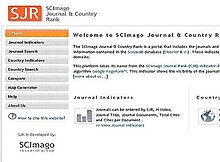SCImago Journal Rank

| Part of a series on |
| Citation metrics |
|---|
 |
The SCImago Journal Rank (SJR) indicator is a measure of the scientific influence of scholarly journals that accounts for both the number of citations received by a journal and the importance or prestige of the journals where the citations come from. A journal's SJR indicator is a numeric value representing the average number of weighted citations received during a selected year per document published in that journal during the previous three years, as indexed by Scopus. Higher SJR indicator values are meant to indicate greater journal prestige. SJR is developed by the Scimago Lab,[1] originated from a research group at University of Granada.
The SJR indicator is a variant of the eigenvector centrality measure used in network theory. Such measures establish the importance of a node in a network based on the principle that connections to high-scoring nodes contribute more to the score of the node. The SJR indicator has been developed to be used in extremely large and heterogeneous journal citation networks. It is a size-independent indicator and its values order journals by their "average prestige per article" and can be used for journal comparisons in science evaluation processes. The SJR indicator is a free journal metric inspired by, and using an algorithm similar to, PageRank.
In addition to the network-based SJR indicator, the SJR also provides a more direct alternative to the impact factor (IF), in the form of average citations per document in a 2-year period, abbreviated as Cites per Doc. (2y).[2][3]
Rationale[]
If scientific impact is considered related to the number of endorsements, in the form of citations, a journal receives, then prestige can be understood as a combination of the number of endorsements and the prestige or importance of the journals issuing them. The SJR indicator assigns different values to citations depending on the importance of the journals where they come from. This way, citations coming from highly important journals will be more valuable and hence will provide more prestige to the journals receiving them. The calculation of the SJR indicator is similar to the Eigenfactor score, with the former being based on the Scopus database and the latter on the Web of Science database,[4] and there are other differences.[5]
Computation[]
The SJR indicator computation is carried out using an iterative algorithm that distributes prestige values among the journals until a steady-state solution is reached. The SJR algorithm begins by setting an identical amount of prestige to each journal, then using an iterative procedure, this prestige is redistributed in a process where journals transfer their achieved prestige to each other through citations. The process ends up when the difference between journal prestige values in consecutive iterations do not reach a minimum threshold value any more. The process is developed in two phases, (a) the computation of Prestige SJR (PSJR) for each journal: a size-dependent measure that reflects the whole journal prestige, and (b) the normalization of this measure to achieve a size-independent measure of prestige, the SJR indicator.[6]
See also[]
References[]
- ^ "Scimago Lab". Scimago Lab Website. Retrieved 22 July 2021.
- ^ Declan Butler (2 January 2008). "Free journal-ranking tool enters citation market". Nature. 451 (6): 6. Bibcode:2008Natur.451....6B. doi:10.1038/451006a. PMID 18172465.
- ^ Matthew E. Falagas; et al. (2008). "Comparison of SCImago journal rank indicator with journal impact factor". The FASEB Journal. 22 (8): 2623–2628. doi:10.1096/fj.08-107938. PMID 18408168.
- ^ "SCImago Journal & Country Rank (SJR) as an alternative to Thomson Reuters's Impact Factor and EigenFactor". 21 Aug 2008. Archived from the original on 2013-04-26. Retrieved 20 September 2012.
- ^ "Network-based Citation Metrics: Eigenfactor vs. SJR". 28 Jul 2015. Archived from the original on 2020-04-26. Retrieved 26 Apr 2020.
- ^ SCImago Journal & Country Rank. "DESCRIPTION OF SCIMAGO JOURNAL RANK INDICATOR" (PDF). SCImago Journal & Country Rank. Retrieved 20 March 2018.
External links[]
- Official website
- A "description, in plain English" of Network-based Citation Metrics: Eigenfactor vs. SJR.
- Academic publishing
- Journal ranking
- Citation indices